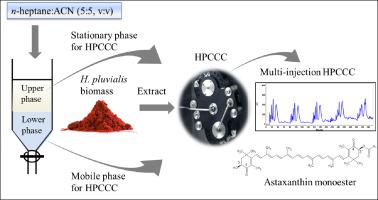Algal Research ( IF 4.6 ) Pub Date : 2020-05-25 , DOI: 10.1016/j.algal.2020.101947 Tereza Fábryová , Lenka Tůmová , Daniela Correia da Silva , David M. Pereira , Paula B. Andrade , Patrícia Valentão , Pavel Hrouzek , Jiří Kopecký , José Cheel

|
Astaxanthin is a potent natural antioxidant with beneficial bioactivities demonstrated primarily for its free (non-esterified) form. However, its natural producer, the microalgae Haematococcus pluvialis synthesizes astaxanthin mostly in ester forms which have been little valorized so far. Hence, to contribute to the commercial use of astaxanthin esters, a scalable and efficient isolation technology is required. In this study, five astaxanthin monoesters were isolated from H. pluvialis using high performance countercurrent chromatography (HPCCC), where the lower phase of a biphasic solvent system (n-heptane:acetonitrile, ratio 5:5, v/v) was used as a mobile phase. Around 200 mg of biomass extract was subjected to the HPCCC leading to a separation of the target astaxanthin esters. To further increase the process productivity, a multi-injection HPCCC method was developed by combining two elution modes (reverse phase and co-current). In co-current elution mode, both the mobile and stationary phases were pumped simultaneously at flow rates of 3 and 1 mL/min respectively, so that the stationary phase that gets lost during each separation cycle is replenished. In total, five injections of samples (200 mg of extract, each) were achieved. Final purification with high performance liquid chromatography (HPLC) afforded five astaxanthin derivatives esterified with α-linolenic acid (1, 4 mg), linoleic acid (2, 8 mg), palmitic acid (3, 8 mg), oleic acid (4, 12 mg) and stearic acid (5, 1 mg) with purities of 98%, as determined by HPLC analysis. Only compound 4 exhibited a cytotoxic effect against human gastric cancer cells. The present study shows a useful approach for obtaining individual astaxanthin esters from H. pluvialis.
中文翻译:

从微藻虾青素的单酯的分离雨生红球通过结合高效液相色谱高性能逆流色谱法(HPCCC)(HPLC)
虾青素是一种有效的天然抗氧化剂,主要以其游离(未酯化)形式具有有益的生物活性。然而,它的天然生产者微藻类嗜血红球菌主要以酯形式合成虾青素,迄今为止鲜有增值。因此,为了促进虾青素酯的商业用途,需要可扩展且有效的分离技术。在这项研究中,虾青素5个单酯是从分离H.生红球藻用高性能逆流色谱法(HPCCC),其中的两相溶剂体系的下层相(Ñ乙腈,比5::5,庚烷v / v)用作流动相。对约200 mg的生物质提取物进行HPCCC处理,从而分离出目标虾青素酯。为了进一步提高过程生产率,通过结合两种洗脱模式(反相和并流)开发了多进样HPCCC方法。在并流洗脱模式下,流动相和固定相分别以3 mL / min和1 mL / min的流速同时泵送,以补充在每个分离循环中丢失的固定相。总共进样五次(每次200毫克提取物)。最终的纯化用得到的虾青素5个衍生物高效液相色谱法(HPLC)与α亚麻酸(酯化1, 4毫克),亚油酸(2,8毫克),棕榈酸(3, 8毫克),油酸(4, 12毫克)和硬脂酸(5, 1毫克)与98%的纯度,如通过HPLC分析测定。仅化合物4显示出对人胃癌细胞的细胞毒性作用。本研究显示了一种有用的方法,用于从幽门螺杆菌中获得单个虾青素酯。











































 京公网安备 11010802027423号
京公网安备 11010802027423号